
reader
Convert any URL to an LLM-friendly input with a simple prefix https://r.jina.ai/
Stars: 8465

Reader is a tool that converts any URL to an LLM-friendly input with a simple prefix `https://r.jina.ai/`. It improves the output for your agent and RAG systems at no cost. Reader supports image reading, captioning all images at the specified URL and adding `Image [idx]: [caption]` as an alt tag. This enables downstream LLMs to interact with the images in reasoning, summarizing, etc. Reader offers a streaming mode, useful when the standard mode provides an incomplete result. In streaming mode, Reader waits a bit longer until the page is fully rendered, providing more complete information. Reader also supports a JSON mode, which contains three fields: `url`, `title`, and `content`. Reader is backed by Jina AI and licensed under Apache-2.0.
README:
Your LLMs deserve better input.
Reader does two things:
-
Read: It converts any URL to an LLM-friendly input with
https://r.jina.ai/https://your.url. Get improved output for your agent and RAG systems at no cost. -
Search: It searches the web for a given query with
https://s.jina.ai/your+query. This allows your LLMs to access the latest world knowledge from the web.
Check out the live demo
Or just visit these URLs (Read) https://r.jina.ai/https://github.com/jina-ai/reader, (Search) https://s.jina.ai/Who%20will%20win%202024%20US%20presidential%20election%3F and see yourself.
Feel free to use Reader API in production. It is free, stable and scalable. We are maintaining it actively as one of the core products of Jina AI. Check out rate limit
-
2024-10-08: Introduced an
adaptive crawler. It can recursively crawl the website and extract the most relevant pages for a given webpage. -
2024-07-15: To restrict the results of
s.jina.aito certain domain/website, you can set e.g.site=jina.aiin the query parameters, which enables in-site search. For more options, try our updated live-demo. - 2024-07-01: We have resolved a DDoS attack and other traffic abusing since June 27th. We also found a bug introduced on June 28th which may cause higher latency for some websites. The attack and the bug have been solved; if you have experienced high latency of r.jina.ai between June 27th-30th, it should back to normal now.
- 2024-05-30: Reader can now read abitrary PDF from any URL! Check out this PDF result from NASA.gov vs the original.
-
2024-05-15: We introduced a new endpoint
s.jina.aithat searches on the web and return top-5 results, each in a LLM-friendly format. Read more about this new feature here. -
2024-05-08: Image caption is off by default for better latency. To turn it on, set
x-with-generated-alt: truein the request header. - 2024-05-03: We finally resolved a DDoS attack since April 29th. Now our API is much more reliable and scalable than ever!
- 2024-04-24: You now have more fine-grained control over Reader API using headers, e.g. forwarding cookies, using HTTP proxy.
-
2024-04-15: Reader now supports image reading! It captions all images at the specified URL and adds
Image [idx]: [caption]as an alt tag (if they initially lack one). This enables downstream LLMs to interact with the images in reasoning, summarizing etc. See example here.
Simply prepend https://r.jina.ai/ to any URL. For example, to convert the URL https://en.wikipedia.org/wiki/Artificial_intelligence to an LLM-friendly input, use the following URL:
https://r.jina.ai/https://en.wikipedia.org/wiki/Artificial_intelligence
Simply prepend https://s.jina.ai/ to your search query. Note that if you are using this in the code, make sure to encode your search query first, e.g. if your query is Who will win 2024 US presidential election? then your url should look like:
https://s.jina.ai/Who%20will%20win%202024%20US%20presidential%20election%3F
Behind the scenes, Reader searches the web, fetches the top 5 results, visits each URL, and applies r.jina.ai to it. This is different from many web search function-calling in agent/RAG frameworks, which often return only the title, URL, and description provided by the search engine API. If you want to read one result more deeply, you have to fetch the content yourself from that URL. With Reader, http://s.jina.ai automatically fetches the content from the top 5 search result URLs for you (reusing the tech stack behind http://r.jina.ai). This means you don't have to handle browser rendering, blocking, or any issues related to JavaScript and CSS yourself.
Simply specify site in the query parameters such as:
curl 'https://s.jina.ai/When%20was%20Jina%20AI%20founded%3F?site=jina.ai&site=github.com'We highly recommend using the code builder to explore different parameter combinations of the Reader API.
As you have already seen above, one can control the behavior of the Reader API using request headers. Here is a complete list of supported headers.
- You can enable the image caption feature via the
x-with-generated-alt: trueheader. - You can ask the Reader API to forward cookies settings via the
x-set-cookieheader.- Note that requests with cookies will not be cached.
- You can bypass
readabilityfiltering via thex-respond-withheader, specifically:-
x-respond-with: markdownreturns markdown without going throughreability -
x-respond-with: htmlreturnsdocumentElement.outerHTML -
x-respond-with: textreturnsdocument.body.innerText -
x-respond-with: screenshotreturns the URL of the webpage's screenshot
-
- You can specify a proxy server via the
x-proxy-urlheader. - You can customize cache tolerance via the
x-cache-toleranceheader (integer in seconds). - You can bypass the cached page (lifetime 3600s) via the
x-no-cache: trueheader (equivalent ofx-cache-tolerance: 0). - If you already know the HTML structure of your target page, you may specify
x-target-selectororx-wait-for-selectorto direct the Reader API to focus on a specific part of the page.- By setting
x-target-selectorheader to a CSS selector, the Reader API return the content within the matched element, instead of the full HTML. Setting this header is useful when the automatic content extraction fails to capture the desired content and you can manually select the correct target. - By setting
x-wait-for-selectorheader to a CSS selector, the Reader API will wait until the matched element is rendered before returning the content. If you already specifiedx-wait-for-selector, this header can be omitted if you plan to wait for the same element.
- By setting
Many websites nowadays rely on JavaScript frameworks and client-side rendering. Usually known as Single Page Application (SPA). Thanks to Puppeteer and headless Chrome browser, Reader natively supports fetching these websites. However, due to specific approach some SPA are developed, there may be some extra precautions to take.
By definition of the web standards, content come after # in a URL is not sent to the server. To mitigate this issue, use POST method with url parameter in body.
curl -X POST 'https://r.jina.ai/' -d 'url=https://example.com/#/route' Some SPAs, or even some websites that are not strictly SPAs, may show preload contents before later loading the main content dynamically. In this case, Reader may be capturing the preload content instead of the main content. To mitigate this issue, here are some possible solutions:
When timeout is explicitly specified, Reader will not attempt to return early and will wait for network idle until the timeout is reached. This is useful when the target website will eventually come to a network idle.
curl 'https://example.com/' -H 'x-timeout: 30'When wait-for-selector is explicitly specified, Reader will wait for the appearance of the specified CSS selector until timeout is reached. This is useful when you know exactly what element to wait for.
curl 'https://example.com/' -H 'x-wait-for-selector: #content'Streaming mode is useful when you find that the standard mode provides an incomplete result. This is because the Reader will wait a bit longer until the page is stablely rendered. Use the accept-header to toggle the streaming mode:
curl -H "Accept: text/event-stream" https://r.jina.ai/https://en.m.wikipedia.org/wiki/Main_PageThe data comes in a stream; each subsequent chunk contains more complete information. The last chunk should provide the most complete and final result. If you come from LLMs, please note that it is a different behavior than the LLMs' text-generation streaming.
For example, compare these two curl commands below. You can see streaming one gives you complete information at last, whereas standard mode does not. This is because the content loading on this particular site is triggered by some js after the page is fully loaded, and standard mode returns the page "too soon".
curl -H 'x-no-cache: true' https://access.redhat.com/security/cve/CVE-2023-45853
curl -H "Accept: text/event-stream" -H 'x-no-cache: true' https://r.jina.ai/https://access.redhat.com/security/cve/CVE-2023-45853Note:
-H 'x-no-cache: true'is used only for demonstration purposes to bypass the cache.
Streaming mode is also useful if your downstream LLM/agent system requires immediate content delivery or needs to process data in chunks to interleave I/O and LLM processing times. This allows for quicker access and more efficient data handling:
Reader API: streamContent1 ----> streamContent2 ----> streamContent3 ---> ...
| | |
v | |
Your LLM: LLM(streamContent1) | |
v |
LLM(streamContent2) |
v
LLM(streamContent3)
Note that in terms of completeness: ... > streamContent3 > streamContent2 > streamContent1, each subsequent chunk contains more complete information.
This is still very early and the result is not really a "useful" JSON. It contains three fields url, title and content only. Nonetheless, you can use accept-header to control the output format:
curl -H "Accept: application/json" https://r.jina.ai/https://en.m.wikipedia.org/wiki/Main_PageJSON mode is probably more useful in s.jina.ai than r.jina.ai. For s.jina.ai with JSON mode, it returns 5 results in a list, each in the structure of {'title', 'content', 'url'}.
All images in that page that lack alt tag can be auto-captioned by a VLM (vision langauge model) and formatted as !(Image [idx]: [VLM_caption])[img_URL]. This should give your downstream text-only LLM just enough hints to include those images into reasoning, selecting, and summarization. Use the x-with-generated-alt header to toggle the streaming mode:
curl -H "X-With-Generated-Alt: true" https://r.jina.ai/https://en.m.wikipedia.org/wiki/Main_PageYou will need the following tools to run the project:
- Node v18 (The build fails for Node version >18)
git clone [email protected]:jina-ai/reader.git
npm installYou might notice a reference to thinapps-shared submodule, an internal package we use to share code across our products. While it’s not open-sourced and isn't integral to the Reader's functions, it mainly helps with decorators, logging, secrets management, etc. Feel free to ignore it for now.
That said, this is the single codebase behind https://r.jina.ai, so everytime we commit here, we will deploy the new version to the https://r.jina.ai.
Please raise an issue with the URL you are having trouble with. We will look into it and try to fix it.
Reader is backed by Jina AI and licensed under Apache-2.0.
For Tasks:
Click tags to check more tools for each tasksFor Jobs:
Alternative AI tools for reader
Similar Open Source Tools

reader
Reader is a tool that converts any URL to an LLM-friendly input with a simple prefix `https://r.jina.ai/`. It improves the output for your agent and RAG systems at no cost. Reader supports image reading, captioning all images at the specified URL and adding `Image [idx]: [caption]` as an alt tag. This enables downstream LLMs to interact with the images in reasoning, summarizing, etc. Reader offers a streaming mode, useful when the standard mode provides an incomplete result. In streaming mode, Reader waits a bit longer until the page is fully rendered, providing more complete information. Reader also supports a JSON mode, which contains three fields: `url`, `title`, and `content`. Reader is backed by Jina AI and licensed under Apache-2.0.
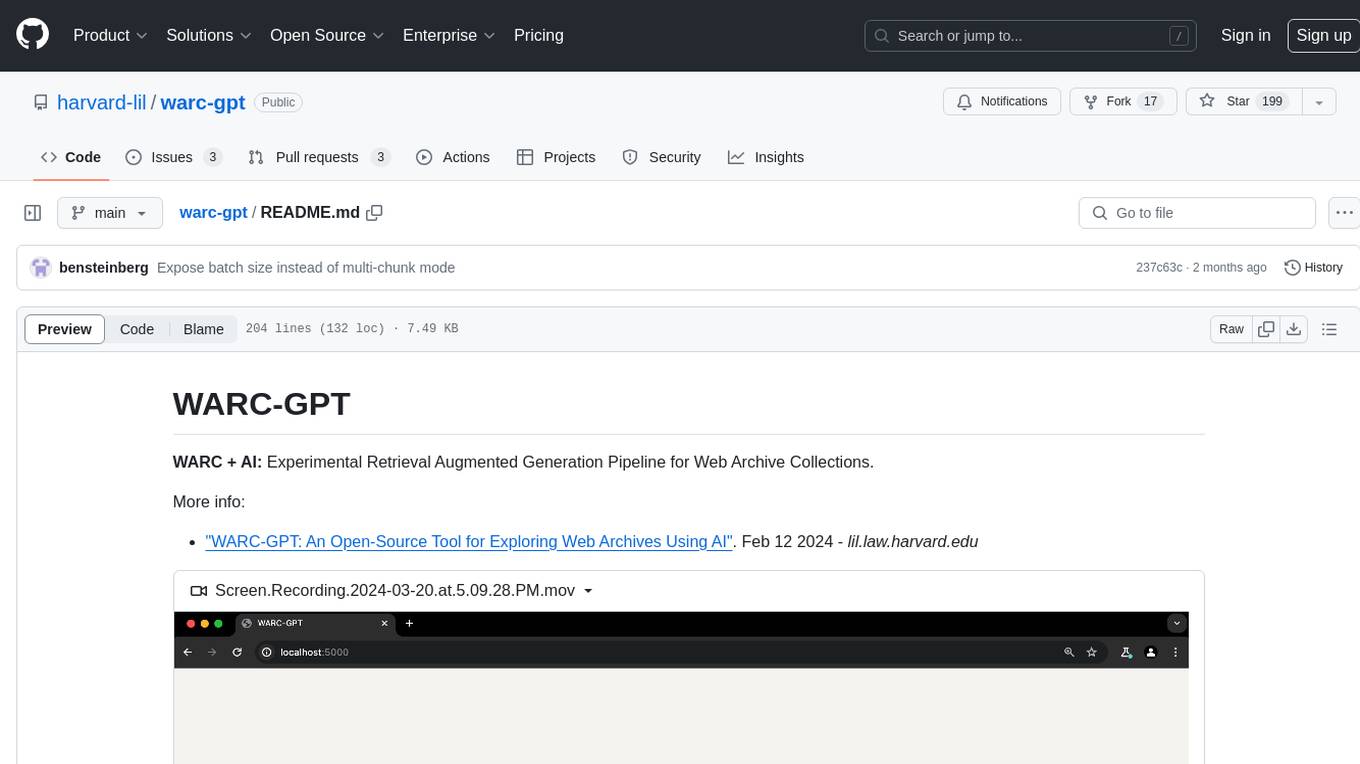
warc-gpt
WARC-GPT is an experimental retrieval augmented generation pipeline for web archive collections. It allows users to interact with WARC files, extract text, generate text embeddings, visualize embeddings, and interact with a web UI and API. The tool is highly customizable, supporting various LLMs, providers, and embedding models. Users can configure the application using environment variables, ingest WARC files, start the server, and interact with the web UI and API to search for content and generate text completions. WARC-GPT is designed for exploration and experimentation in exploring web archives using AI.
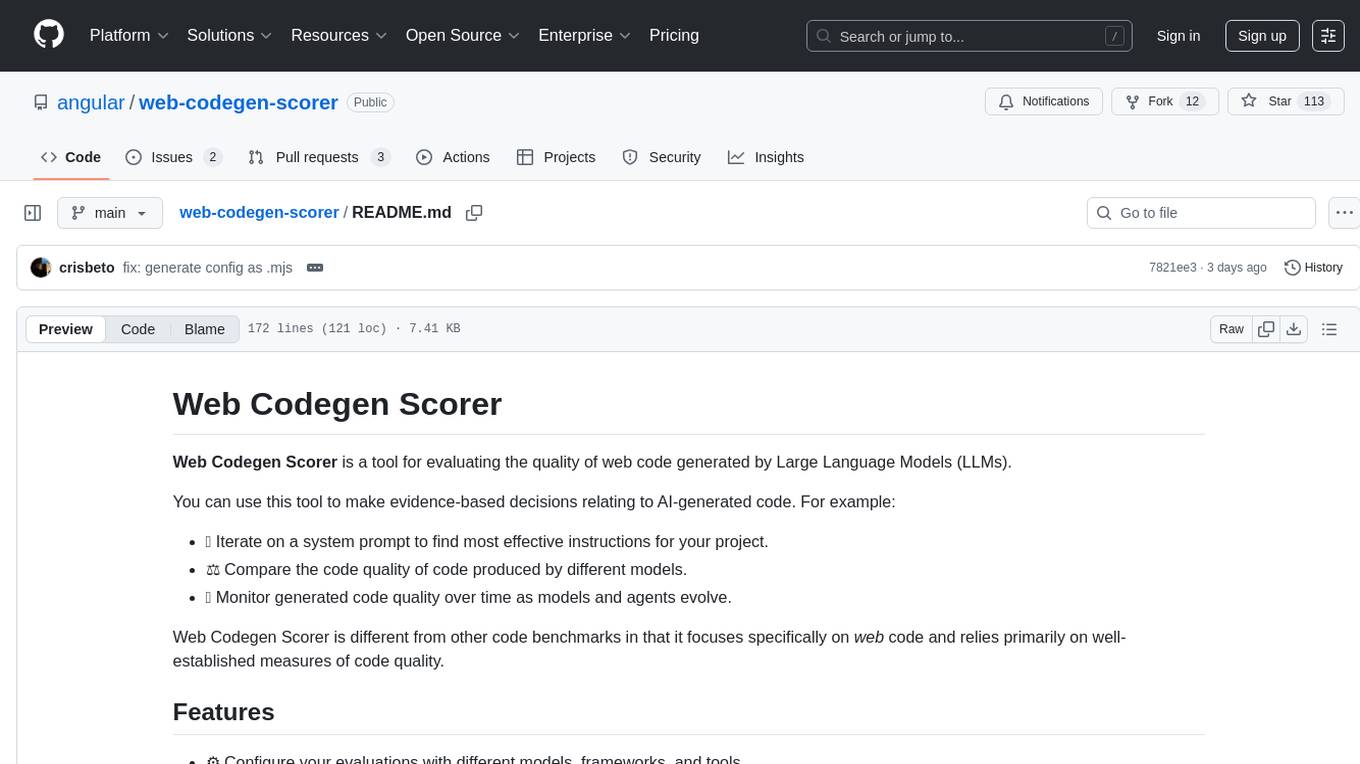
web-codegen-scorer
Web Codegen Scorer is a tool designed to evaluate the quality of web code generated by Large Language Models (LLMs). It allows users to make evidence-based decisions related to AI-generated code by iterating on system prompts, comparing code quality from different models, and monitoring code quality over time. The tool focuses specifically on web code and offers various features such as configuring evaluations, specifying system instructions, using built-in checks for code quality, automatically repairing issues, and viewing results with an intuitive report viewer UI.
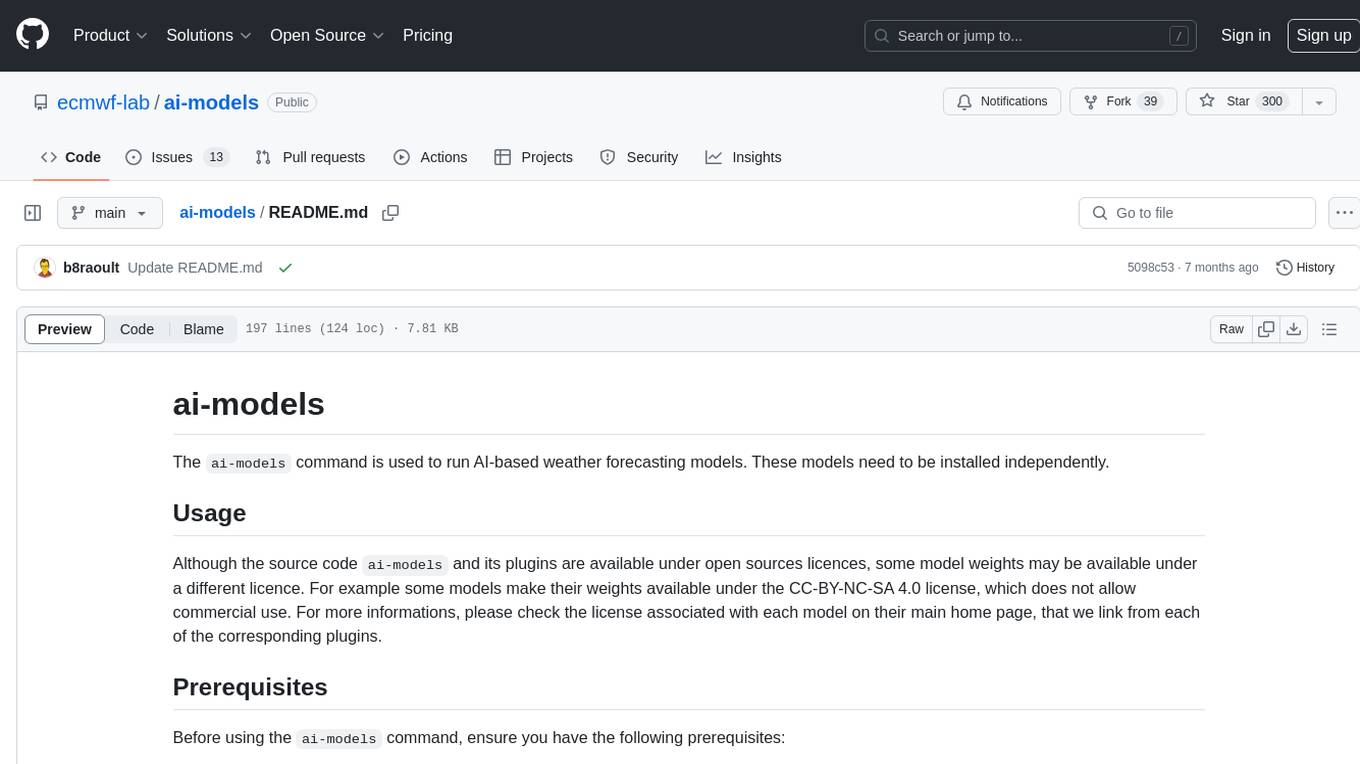
ai-models
The `ai-models` command is a tool used to run AI-based weather forecasting models. It provides functionalities to install, run, and manage different AI models for weather forecasting. Users can easily install and run various models, customize model settings, download assets, and manage input data from different sources such as ECMWF, CDS, and GRIB files. The tool is designed to optimize performance by running on GPUs and provides options for better organization of assets and output files. It offers a range of command line options for users to interact with the models and customize their forecasting tasks.
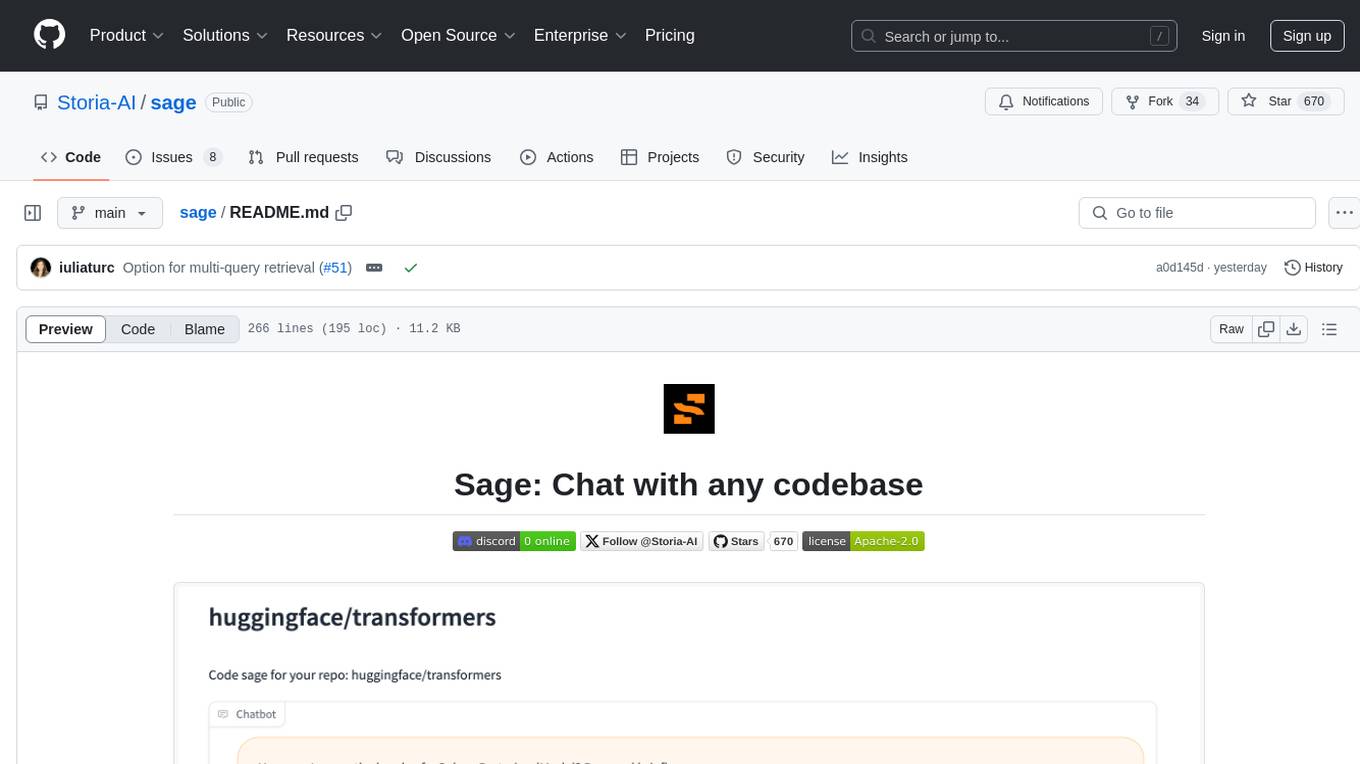
sage
Sage is a tool that allows users to chat with any codebase, providing a chat interface for code understanding and integration. It simplifies the process of learning how a codebase works by offering heavily documented answers sourced directly from the code. Users can set up Sage locally or on the cloud with minimal effort. The tool is designed to be easily customizable, allowing users to swap components of the pipeline and improve the algorithms powering code understanding and generation.
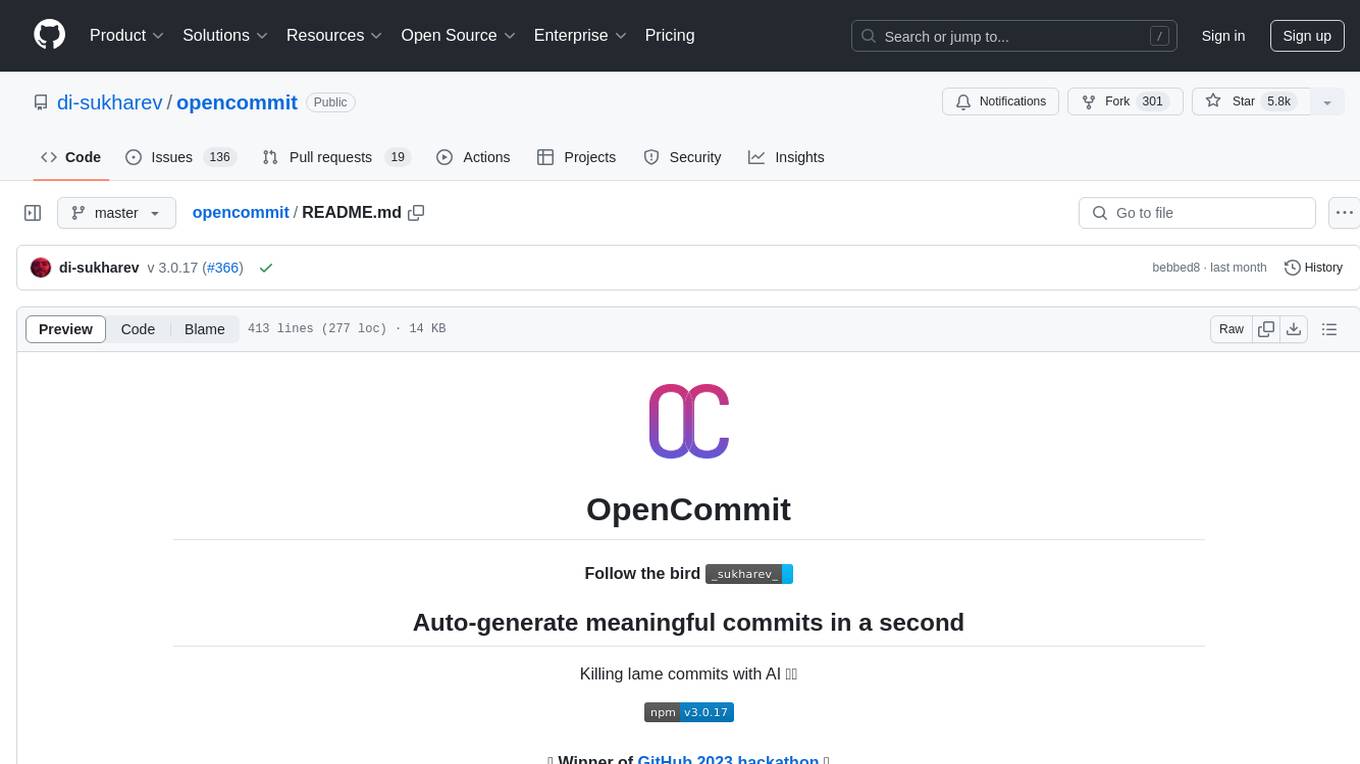
opencommit
OpenCommit is a tool that auto-generates meaningful commits using AI, allowing users to quickly create commit messages for their staged changes. It provides a CLI interface for easy usage and supports customization of commit descriptions, emojis, and AI models. Users can configure local and global settings, switch between different AI providers, and set up Git hooks for integration with IDE Source Control. Additionally, OpenCommit can be used as a GitHub Action to automatically improve commit messages on push events, ensuring all commits are meaningful and not generic. Payments for OpenAI API requests are handled by the user, with the tool storing API keys locally.
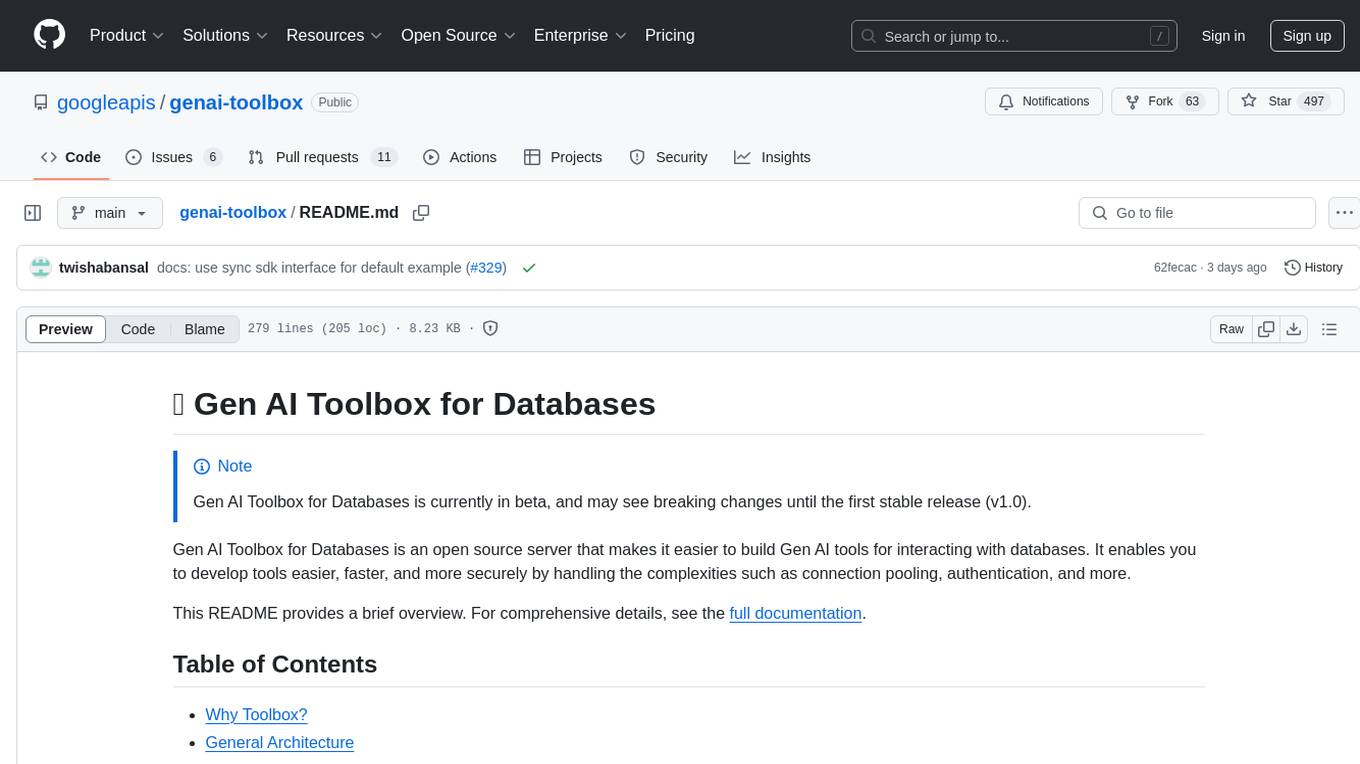
genai-toolbox
Gen AI Toolbox for Databases is an open source server that simplifies building Gen AI tools for interacting with databases. It handles complexities like connection pooling, authentication, and more, enabling easier, faster, and more secure tool development. The toolbox sits between the application's orchestration framework and the database, providing a control plane to modify, distribute, or invoke tools. It offers simplified development, better performance, enhanced security, and end-to-end observability. Users can install the toolbox as a binary, container image, or compile from source. Configuration is done through a 'tools.yaml' file, defining sources, tools, and toolsets. The project follows semantic versioning and welcomes contributions.
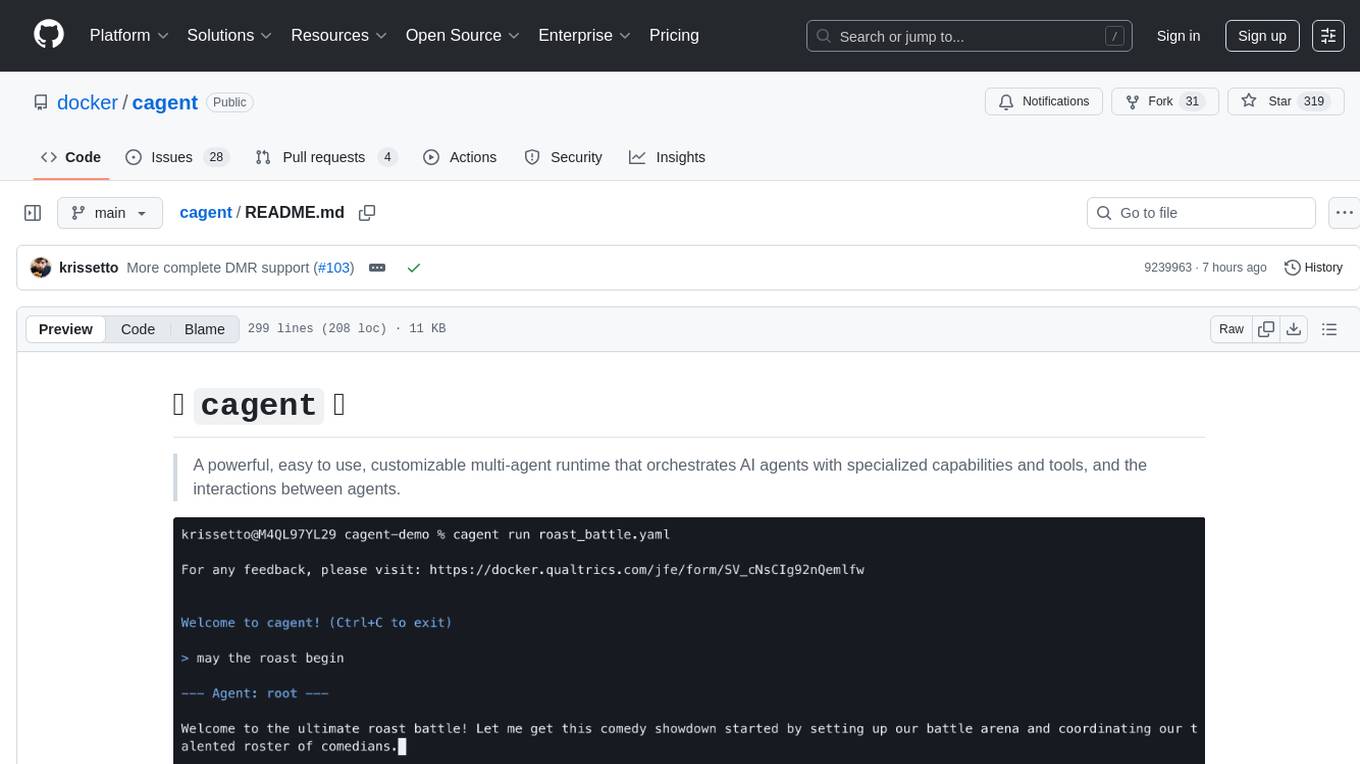
cagent
cagent is a powerful and easy-to-use multi-agent runtime that orchestrates AI agents with specialized capabilities and tools, allowing users to quickly build, share, and run a team of virtual experts to solve complex problems. It supports creating agents with YAML configuration, improving agents with MCP servers, and delegating tasks to specialists. Key features include multi-agent architecture, rich tool ecosystem, smart delegation, YAML configuration, advanced reasoning tools, and support for multiple AI providers like OpenAI, Anthropic, Gemini, and Docker Model Runner.
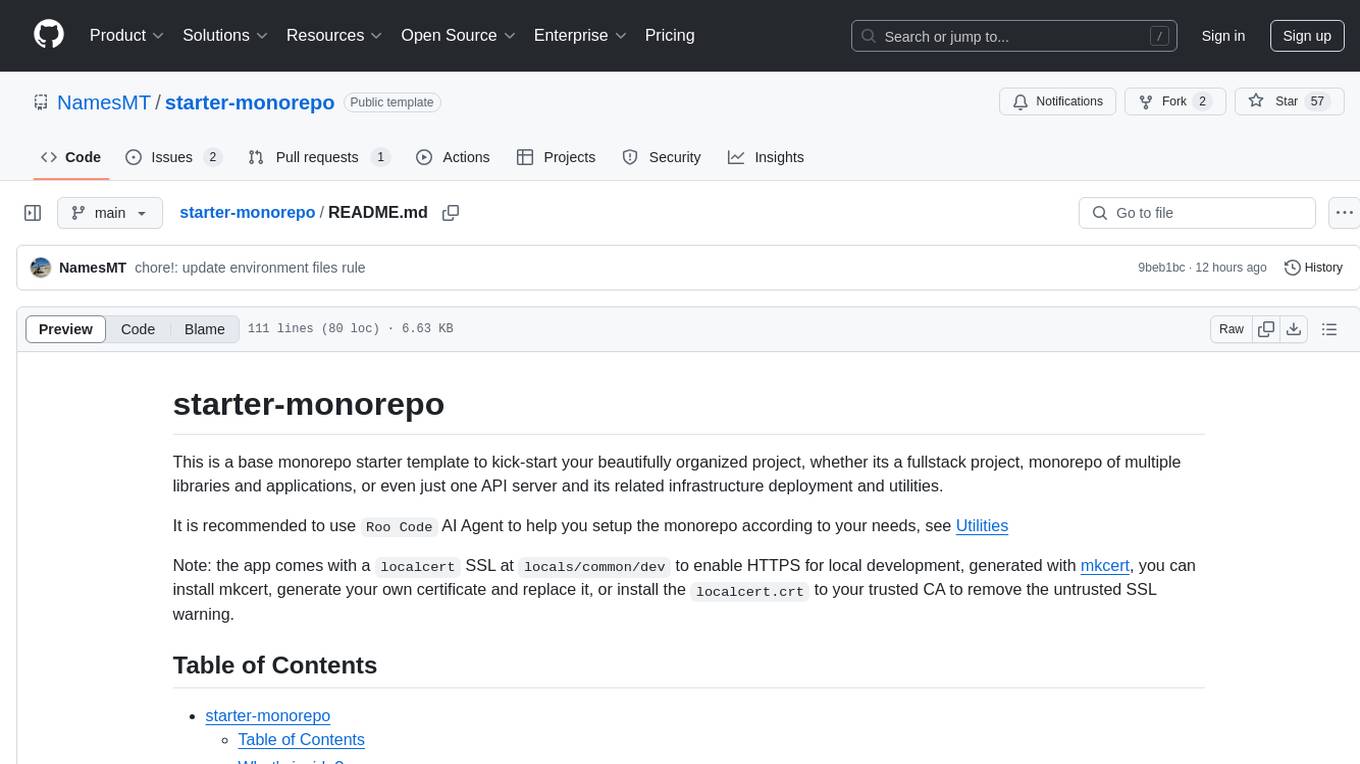
starter-monorepo
Starter Monorepo is a template repository for setting up a monorepo structure in your project. It provides a basic setup with configurations for managing multiple packages within a single repository. This template includes tools for package management, versioning, testing, and deployment. By using this template, you can streamline your development process, improve code sharing, and simplify dependency management across your project. Whether you are working on a small project or a large-scale application, Starter Monorepo can help you organize your codebase efficiently and enhance collaboration among team members.
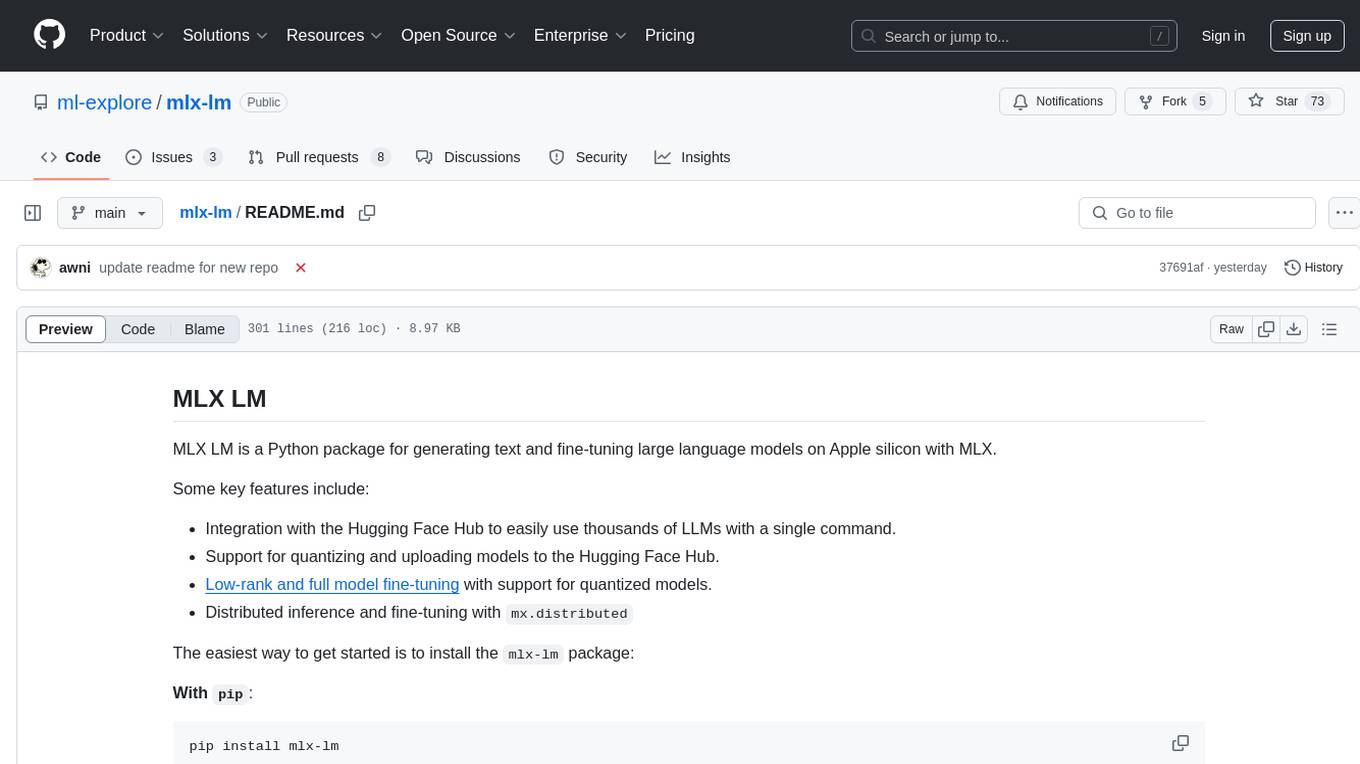
mlx-lm
MLX LM is a Python package designed for generating text and fine-tuning large language models on Apple silicon using MLX. It offers integration with the Hugging Face Hub for easy access to thousands of LLMs, support for quantizing and uploading models to the Hub, low-rank and full model fine-tuning capabilities, and distributed inference and fine-tuning with `mx.distributed`. Users can interact with the package through command line options or the Python API, enabling tasks such as text generation, chatting with language models, model conversion, streaming generation, and sampling. MLX LM supports various Hugging Face models and provides tools for efficient scaling to long prompts and generations, including a rotating key-value cache and prompt caching. It requires macOS 15.0 or higher for optimal performance.
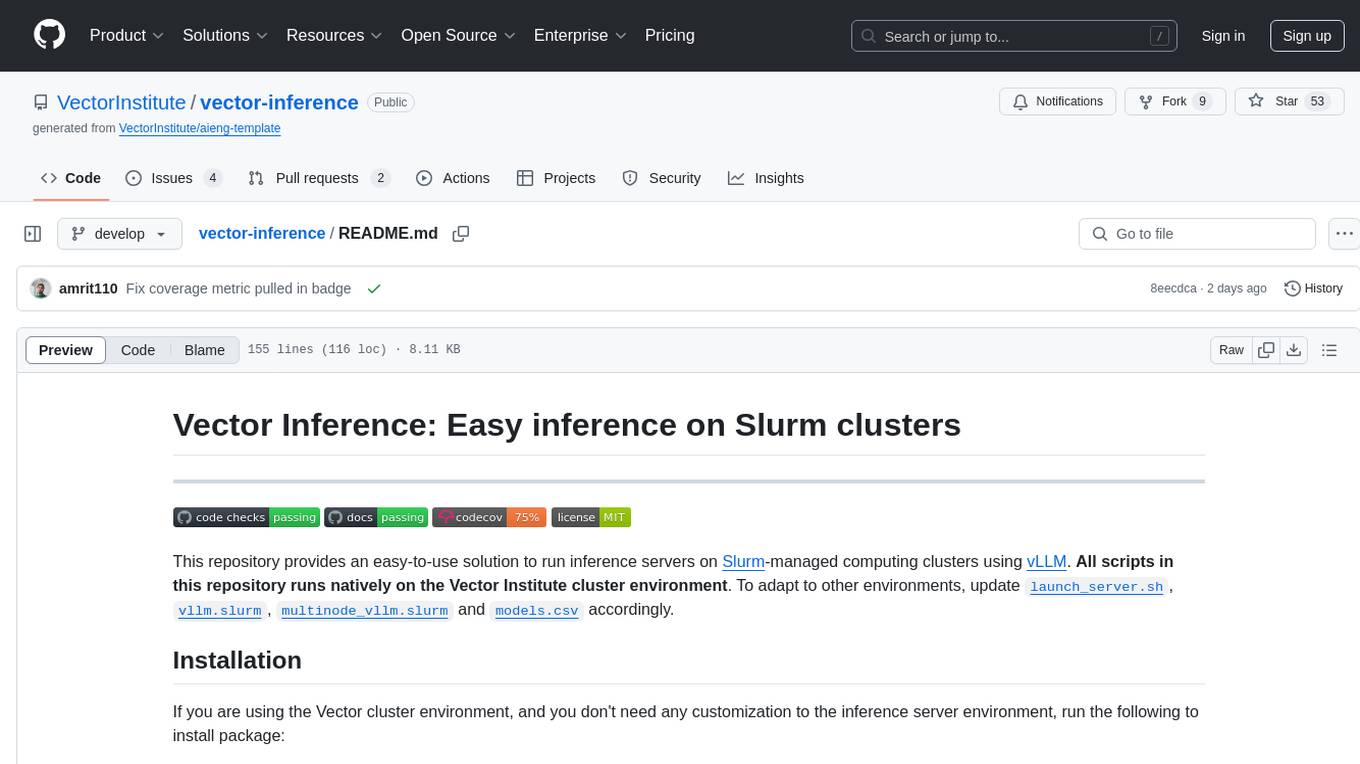
vector-inference
This repository provides an easy-to-use solution for running inference servers on Slurm-managed computing clusters using vLLM. All scripts in this repository run natively on the Vector Institute cluster environment. Users can deploy models as Slurm jobs, check server status and performance metrics, and shut down models. The repository also supports launching custom models with specific configurations. Additionally, users can send inference requests and set up an SSH tunnel to run inference from a local device.
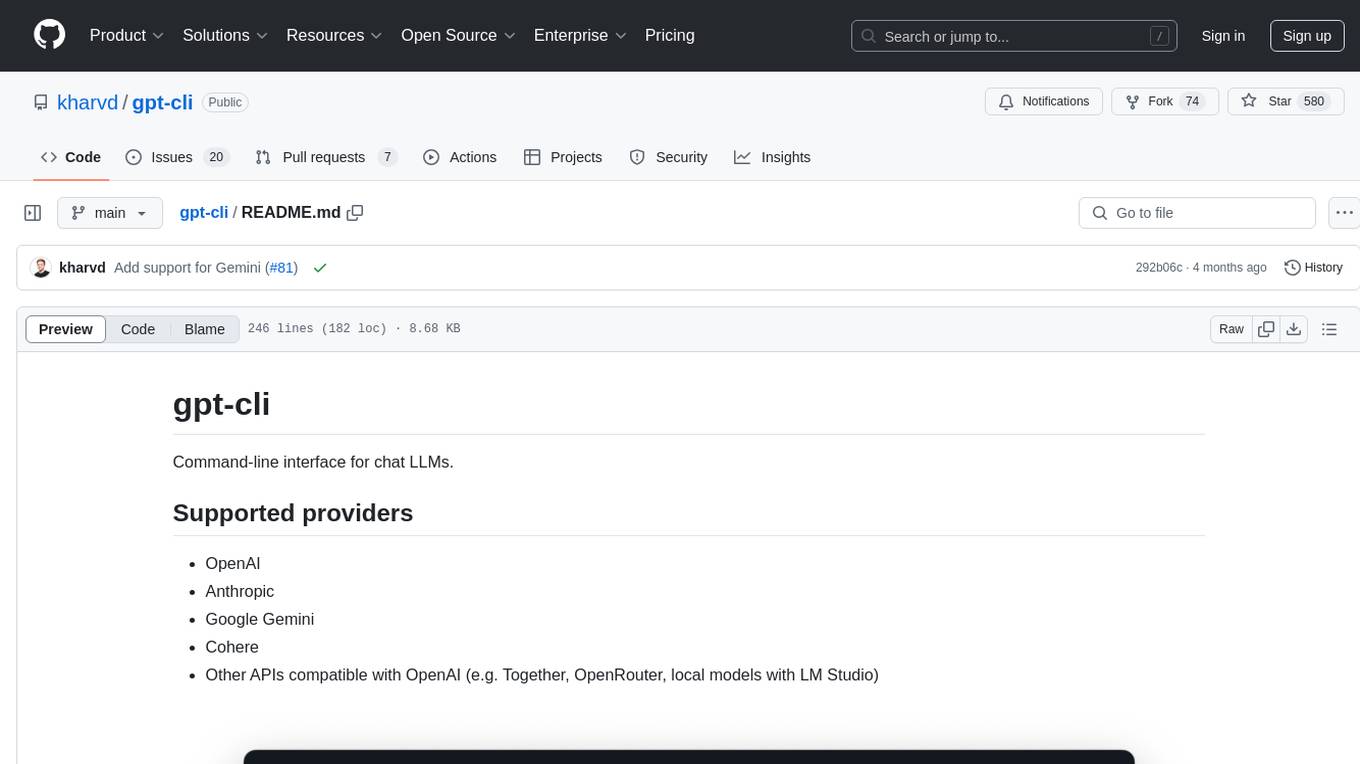
gpt-cli
gpt-cli is a command-line interface tool for interacting with various chat language models like ChatGPT, Claude, and others. It supports model customization, usage tracking, keyboard shortcuts, multi-line input, markdown support, predefined messages, and multiple assistants. Users can easily switch between different assistants, define custom assistants, and configure model parameters and API keys in a YAML file for easy customization and management.
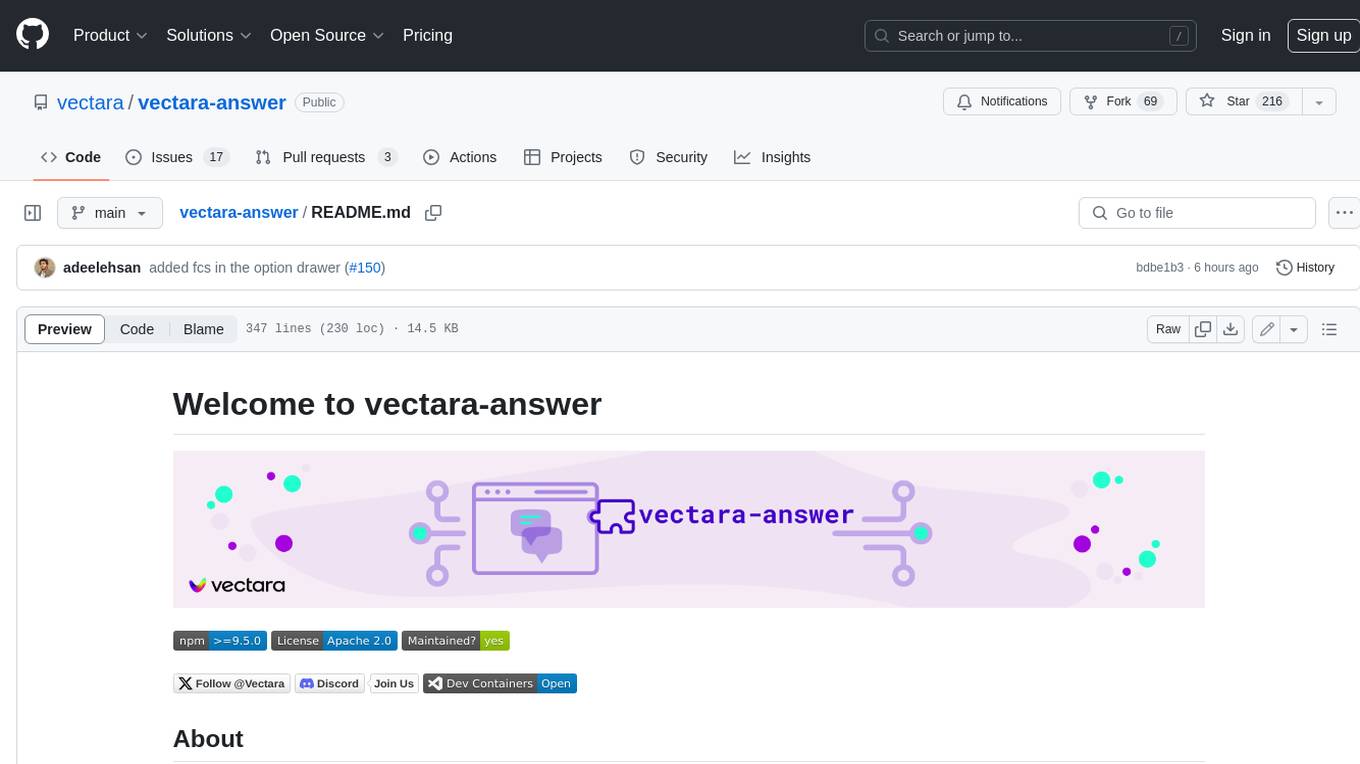
vectara-answer
Vectara Answer is a sample app for Vectara-powered Summarized Semantic Search (or question-answering) with advanced configuration options. For examples of what you can build with Vectara Answer, check out Ask News, LegalAid, or any of the other demo applications.

aider-composer
Aider Composer is a VSCode extension that integrates Aider into your development workflow. It allows users to easily add and remove files, toggle between read-only and editable modes, review code changes, use different chat modes, and reference files in the chat. The extension supports multiple models, code generation, code snippets, and settings customization. It has limitations such as lack of support for multiple workspaces, Git repository features, linting, testing, voice features, in-chat commands, and configuration options.
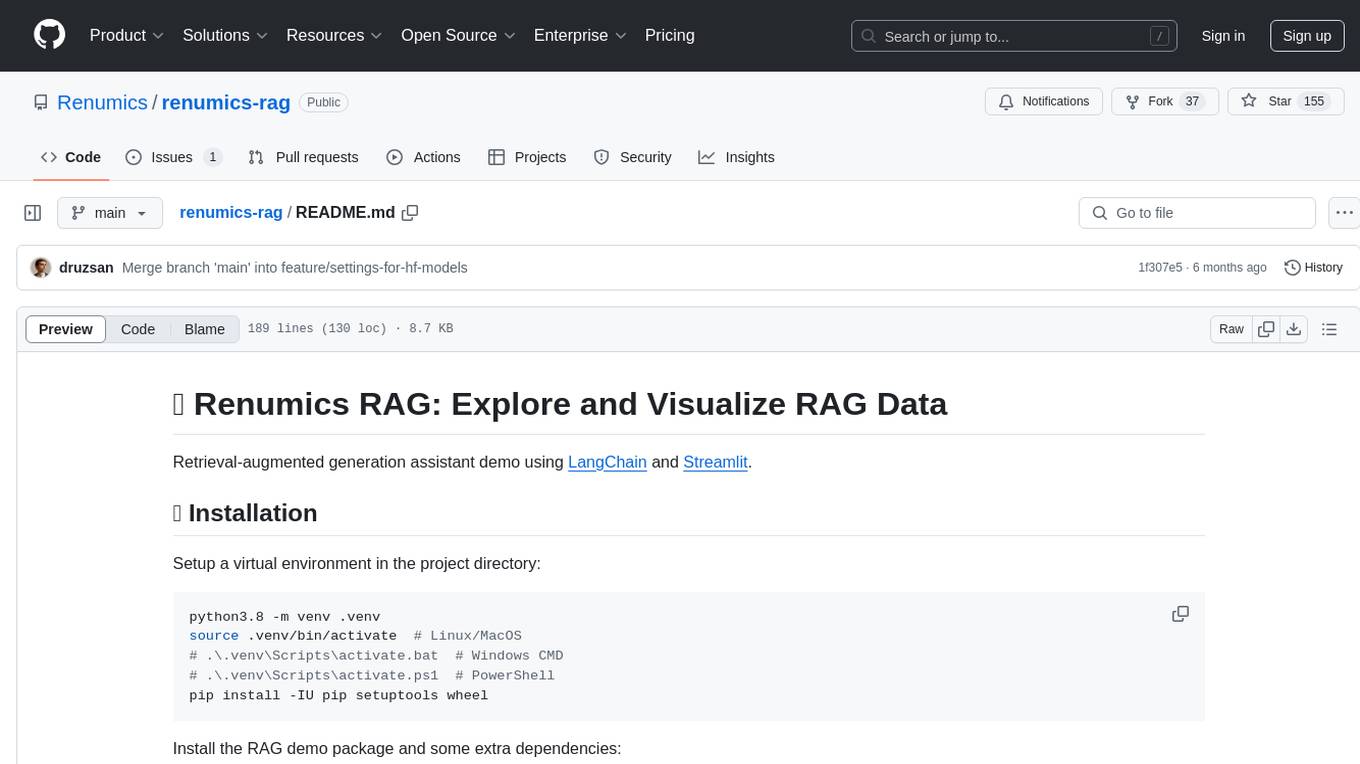
renumics-rag
Renumics RAG is a retrieval-augmented generation assistant demo that utilizes LangChain and Streamlit. It provides a tool for indexing documents and answering questions based on the indexed data. Users can explore and visualize RAG data, configure OpenAI and Hugging Face models, and interactively explore questions and document snippets. The tool supports GPU and CPU setups, offers a command-line interface for retrieving and answering questions, and includes a web application for easy access. It also allows users to customize retrieval settings, embeddings models, and database creation. Renumics RAG is designed to enhance the question-answering process by leveraging indexed documents and providing detailed answers with sources.
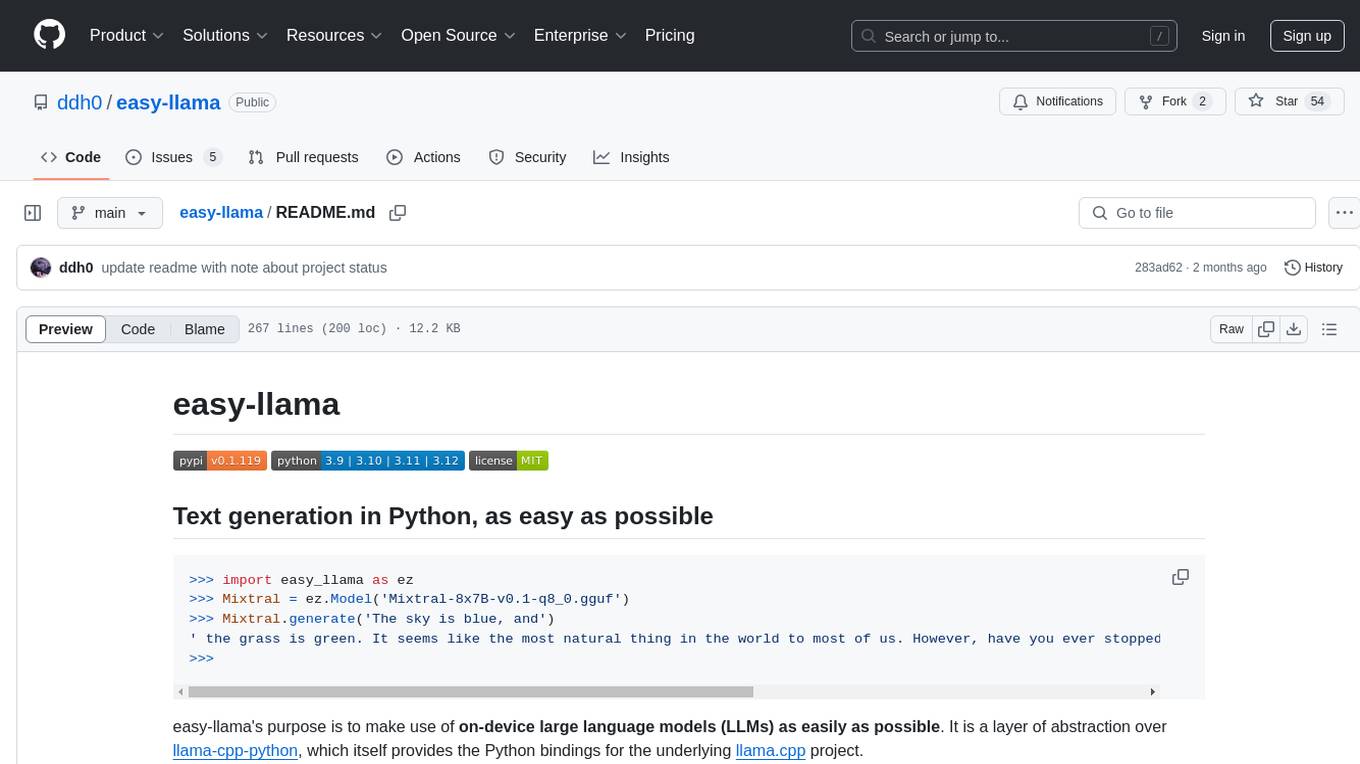
easy-llama
easy-llama is a Python tool designed to make text generation using on-device large language models (LLMs) as easy as possible. It provides an abstraction layer over llama-cpp-python, simplifying the process of utilizing language models. The tool offers features such as automatic context length adjustment, terminal-based interactive chat, programmatic multi-turn interaction, support for various prompt formats, message-based context length handling, retrieval of likely next tokens, and compatibility with multiple models supported by llama-cpp-python. The upcoming version 0.2.0 will remove the llama-cpp-python dependency for improved efficiency and maintainability.
For similar tasks

reader
Reader is a tool that converts any URL to an LLM-friendly input with a simple prefix `https://r.jina.ai/`. It improves the output for your agent and RAG systems at no cost. Reader supports image reading, captioning all images at the specified URL and adding `Image [idx]: [caption]` as an alt tag. This enables downstream LLMs to interact with the images in reasoning, summarizing, etc. Reader offers a streaming mode, useful when the standard mode provides an incomplete result. In streaming mode, Reader waits a bit longer until the page is fully rendered, providing more complete information. Reader also supports a JSON mode, which contains three fields: `url`, `title`, and `content`. Reader is backed by Jina AI and licensed under Apache-2.0.
For similar jobs
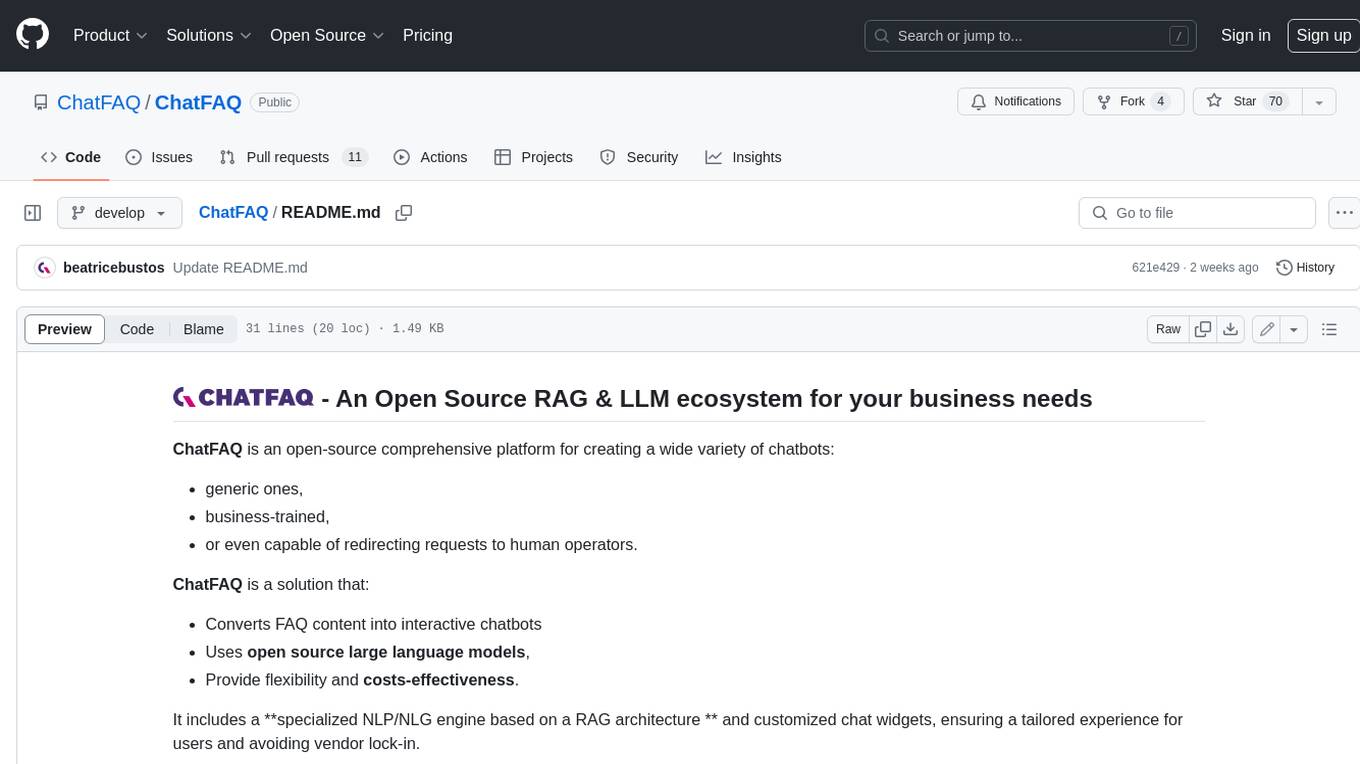
ChatFAQ
ChatFAQ is an open-source comprehensive platform for creating a wide variety of chatbots: generic ones, business-trained, or even capable of redirecting requests to human operators. It includes a specialized NLP/NLG engine based on a RAG architecture and customized chat widgets, ensuring a tailored experience for users and avoiding vendor lock-in.
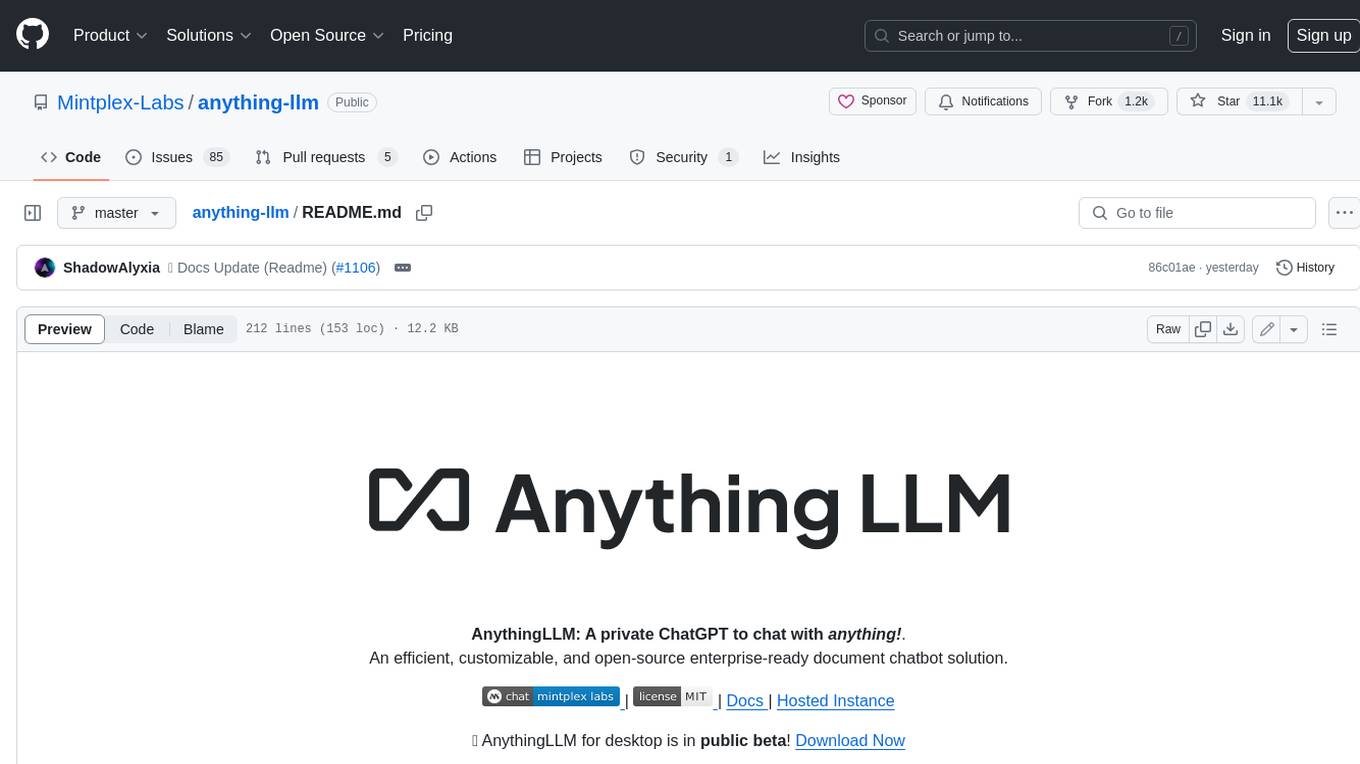
anything-llm
AnythingLLM is a full-stack application that enables you to turn any document, resource, or piece of content into context that any LLM can use as references during chatting. This application allows you to pick and choose which LLM or Vector Database you want to use as well as supporting multi-user management and permissions.

ai-guide
This guide is dedicated to Large Language Models (LLMs) that you can run on your home computer. It assumes your PC is a lower-end, non-gaming setup.

classifai
Supercharge WordPress Content Workflows and Engagement with Artificial Intelligence. Tap into leading cloud-based services like OpenAI, Microsoft Azure AI, Google Gemini and IBM Watson to augment your WordPress-powered websites. Publish content faster while improving SEO performance and increasing audience engagement. ClassifAI integrates Artificial Intelligence and Machine Learning technologies to lighten your workload and eliminate tedious tasks, giving you more time to create original content that matters.
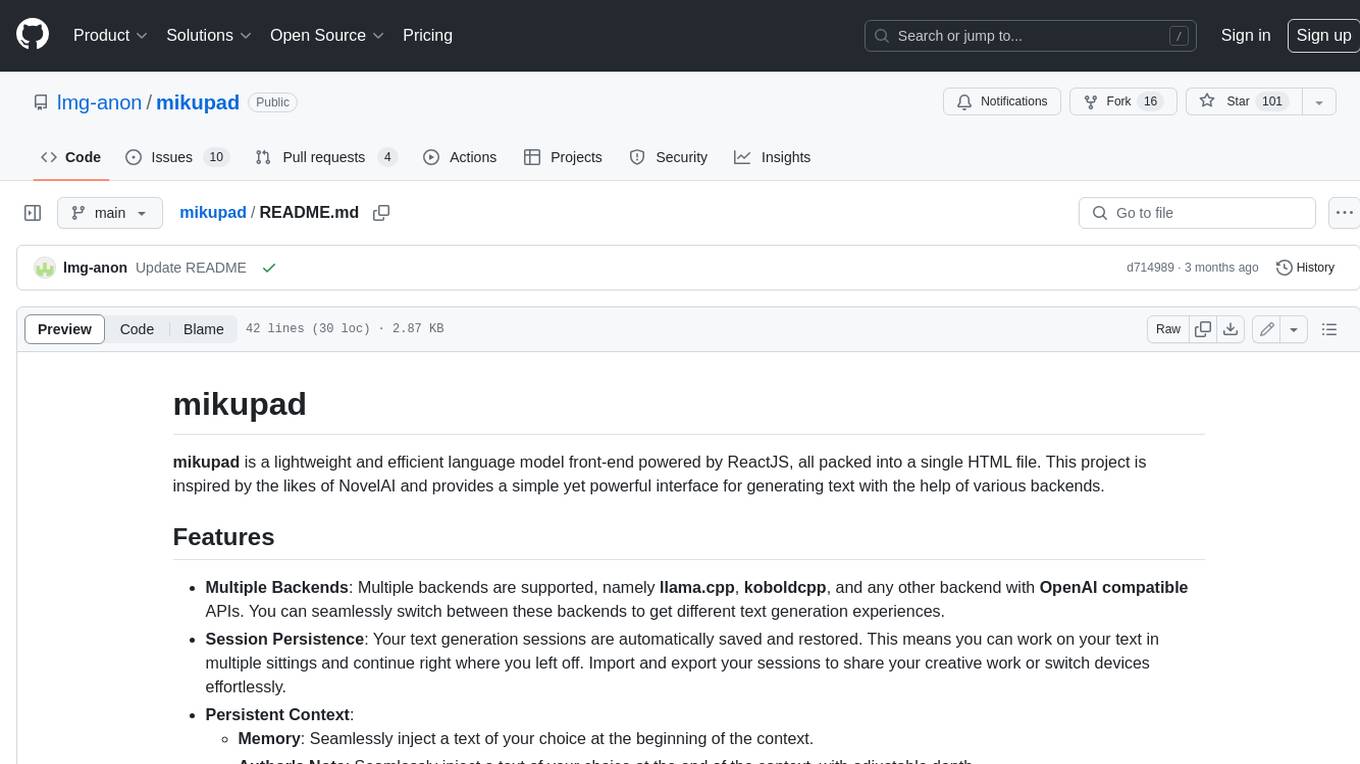
mikupad
mikupad is a lightweight and efficient language model front-end powered by ReactJS, all packed into a single HTML file. Inspired by the likes of NovelAI, it provides a simple yet powerful interface for generating text with the help of various backends.
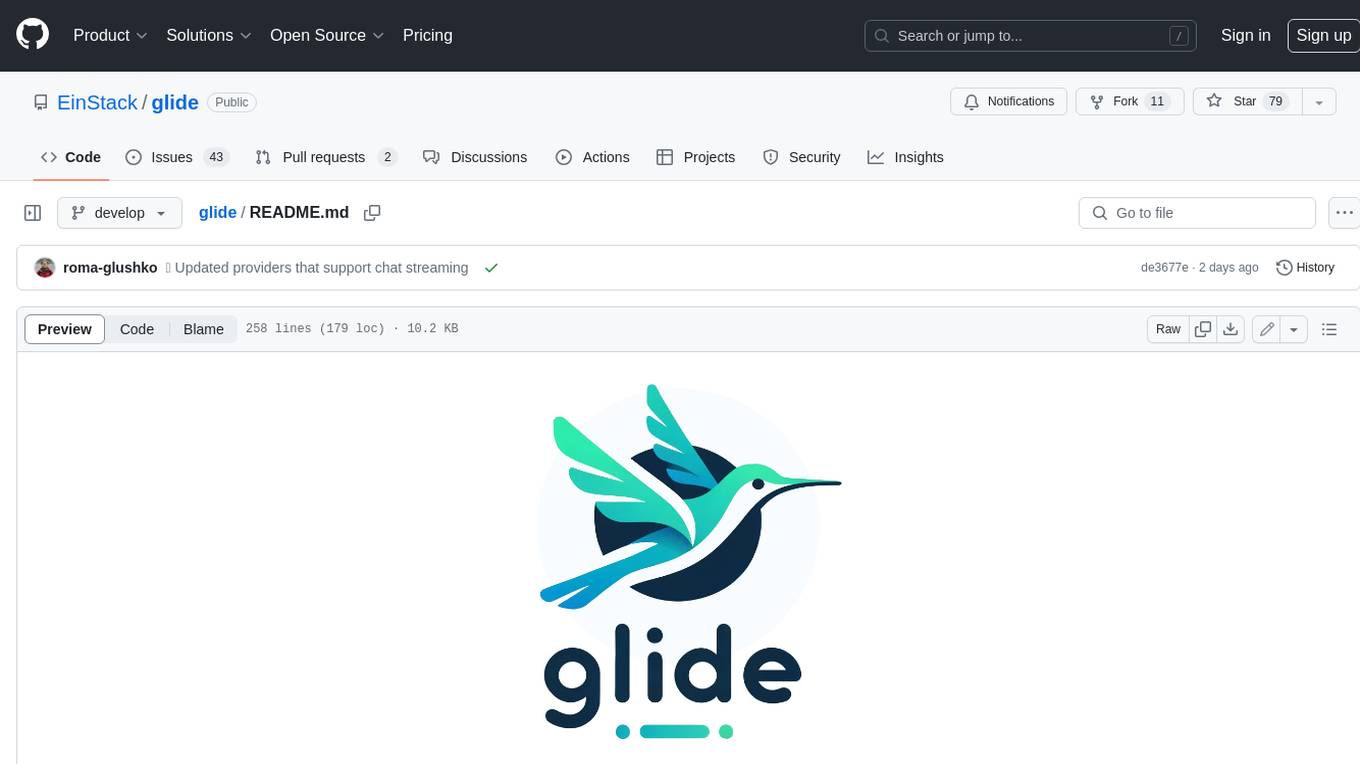
glide
Glide is a cloud-native LLM gateway that provides a unified REST API for accessing various large language models (LLMs) from different providers. It handles LLMOps tasks such as model failover, caching, key management, and more, making it easy to integrate LLMs into applications. Glide supports popular LLM providers like OpenAI, Anthropic, Azure OpenAI, AWS Bedrock (Titan), Cohere, Google Gemini, OctoML, and Ollama. It offers high availability, performance, and observability, and provides SDKs for Python and NodeJS to simplify integration.

onnxruntime-genai
ONNX Runtime Generative AI is a library that provides the generative AI loop for ONNX models, including inference with ONNX Runtime, logits processing, search and sampling, and KV cache management. Users can call a high level `generate()` method, or run each iteration of the model in a loop. It supports greedy/beam search and TopP, TopK sampling to generate token sequences, has built in logits processing like repetition penalties, and allows for easy custom scoring.
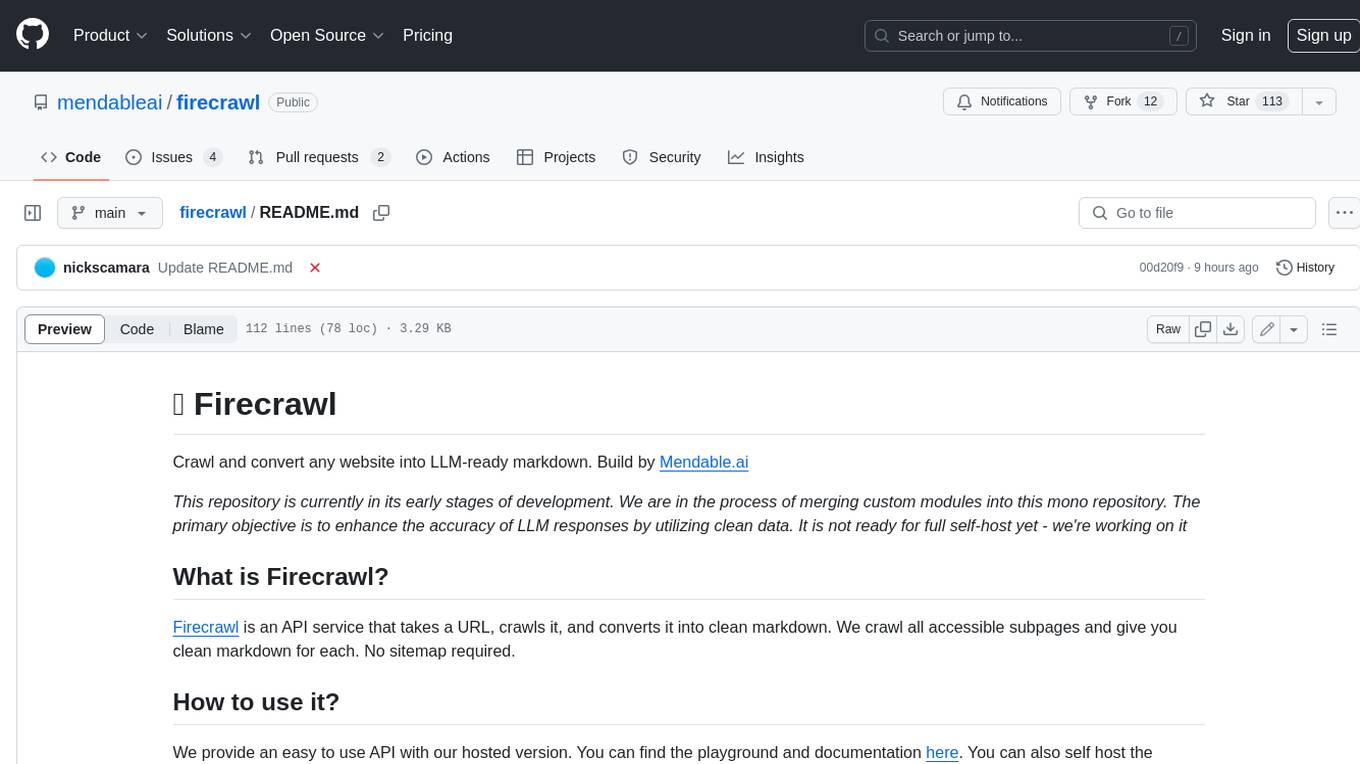
firecrawl
Firecrawl is an API service that takes a URL, crawls it, and converts it into clean markdown. It crawls all accessible subpages and provides clean markdown for each, without requiring a sitemap. The API is easy to use and can be self-hosted. It also integrates with Langchain and Llama Index. The Python SDK makes it easy to crawl and scrape websites in Python code.